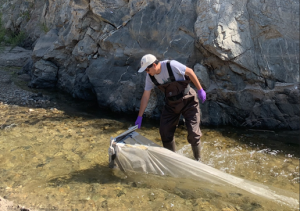Effort launched to standardize microplastics sampling methods

A group of international microplastics experts convened by SCCWRP has begun working to standardize the methods that California is using to collect environmental samples in preparation for measuring their microplastics content – the latest step in California’s ongoing effort to build capacity to comprehensively track microplastics pollution in water bodies statewide.
During a two-day kickoff workshop at SCCWRP in March, about 15 researchers from around the world discussed how environmental managers in California and beyond will be able to more accurately and consistently quantify microplastics levels in four types of environmental samples – ambient water, stormwater, sediment and aquatic life – once the methods used to collect these samples are standardized.
SCCWRP facilitated a similar method standardization effort for microplastics measurement methods last year, enabling microplastics levels to be quantified in consistent ways after environmental samples have reached the laboratory. This earlier effort also standardized microplastics measurement methods for drinking water, which paved the way for California’s Environmental Laboratory Accreditation Program to immediately begin developing standards that enable environmental laboratories to demonstrate proficiency in the measurement methods.
The current effort to standardize sample collection methods is the next phase of a multi-year effort to build a scientifically robust microplastics monitoring toolbox for California – a necessary precursor to developing a comprehensive statewide monitoring program capable of generating high-quality, directly comparable data for tracking the prevalence and spread of microplastics across California’s aquatic environments.
Traditionally, researchers have not used a consistent set of collection methods when sampling ambient water, stormwater, sediment and aquatic life, which has limited researchers’ ability to directly compare microplastics measurement data that have been generated using different sampling methods.
For example, researchers have traditionally collected water samples in the ocean and other water bodies by dragging a manta trawl net along the surface to collect floating debris. However, because smaller microplastics particles can slip through the mesh netting, some researchers have switched to collecting bulk water samples instead. Consequently, when comparing microplastics measurement data generated using the two different collection methods, researchers have been forced to assign a high degree of uncertainty to the comparability of the data.
During the in-person microplastics collection methods workshop, participants divided themselves into four workgroups – one for each of the four types of environmental samples. Each workgroup has been tasked with reaching consensus by summer 2023 on a recommended strategy and study plan for standardizing collection methods, including identifying research projects that are needed to help fill remaining knowledge gaps.

Thus far, workshop participants have concluded that only a few relatively small knowledge gaps remain for ambient water, sediment and aquatic life, but that stormwater sampling will require much more study and optimization to be standardized – a reflection of the fact that stormwater sampling itself is complex, plus stormwater is hypothesized to be a major pathway by which microplastics enter coastal environments.
Once study workplans are developed, researchers will spend the next two years completing method evaluation studies and developing standardized operating procedures (SOPs) for sample collection. This work will also better define uncertainties and limitations of different collection methods and how the results might compare to one another.
As part of their deliberations, workshop participants also have indirectly validated the sample collection methods that the Southern California Bight 2023 Regional Monitoring Program is planning to use this summer to measure microplastics levels in seafloor sediment and bivalves. The planned Bight ’23 sample collection methods are consistent with what the workshop participants agree are best practices sampling techniques.
For more information, contact Dr. Leah Thornton Hampton.
More news related to: Emerging Contaminants, Top News, Trash Pollution